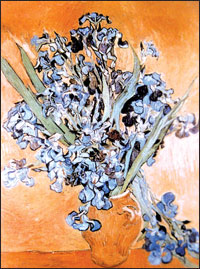The World of ArtsVan
Gogh, a life sustained by a brother
Gwen Herat
A brother’s abiding love throughout life sustained the ever failing
spirit of Van Gogh who otherwise would have died much early and the
world poorer in one man’s art iconism. Among his many siblings Theo who
was born in 1857 stood by Gogh to the end. Vincent Van Gogh who was born
on 30 March, 1853 suffered an excessive morbid imagination in the latter
part of his prosperous life because of a coincident that took place in
his family. One year earlier and exactly on 30 March 1852, his mother
had given birth to a baby boy called Vincent. Ever since he knew about
this drama, Van Gogh secretly imagined whether he was born again. But he
was a Christian and a good Christian at that. His Father was a parson,
Rev. Theo and his mother, Anna who made sure that the Gogh kids spent a
robust forward-thinking lot in a happy environment. The young Gogh was
surrounded by his greatest love, the beauty of his countryside.
|

One of Van Gogh’s paintings |
Gogh was selling others’ art by the time he was sixteen years old
because all his three uncles were involved in dealing with the fine
arts. One of his uncles who worked for the famous French art dealers,
Goupil and Company in Hague, was able to get Gogh employed as an
apprentice in 1869. His brother, Theo started working at Goupil’s
Brussels office in 1872. Gogh was promoted to the London offices of
Goupil in 1873. Without losing the fine opportunity provided to expand a
good art career, Gogh got involved with his landlady’s daughter who
rejected him. He experienced fits of melancholia and later into severe
depressions. As a result of his erratic behaviour, his work suffered
irredeemably. He no longer cared for his job but threw himself to
religion and became less rational.
He was sent to the Paris offices in an attempt to restore his
equilibrium but in Paris, his behaviour became worse. Gogh became
something like a hermit and studied the Bible with frantic fervour.
Goupil permanently dismissed him in 1876. Despite his heartbreak in
London, he had developed an affection to England and returned from Paris
to take up a teaching job that made things worse. He was
poverty-stricken and dejected. But a parson from London, offered him
bed, board and a teaching job.
This became a period of restoration for him with Rev. and Mrs. Shade
Johns becoming his inseperables. He was happy and contented and helped
the poor and stricken around Isleworth and Brixton. During his time in
London, he became more and more concerned for the down-trodden and
dedicated his life towards them by becoming a missionary. He had great
faith in God. He threw himself to preaching but sadly he was looked upon
as strange because of his over powering zest for religion. He lived the
life of hermit style, lived in a squalid insanitary hut and attempted to
the Christ-like. When all thought him to be eccentric, his ever devoted
brother, Theo stood by and sent him money for his expenses.
Later, Gogh realised where his vocation lay and in 1888, announced
‘Zam taking up my pencil again. I am putting myself to drawing anew and
since then everything for me has changed.’
Thus began his illustrious career that spanned over ten years during
which he painted many masterpieces, enhancing the Dutch cultural
heritage. Yet, Gogh’s unconventional behaviour added fuel to his already
prevailing rift with his deeply Christian father that scandalised Hague
society. His father considered having his son committed to an asylum for
the insane but ever faithful brother, Theo stood by him.
However, Gogh continued his painting with undivided attention,
throwing himself to his art in endeavour to forget his problems. Some of
his later paintings are etched with his emotions, strikingly displaying
what was on his mind when he painted. But he went soft on flowers, his
favourite subject which he painted profusely.
After a life of turbulence, disappointment and frustration, Gogh
tragically shot himself which took him two days to die. On 27 July,
1890. Befittingly, Theo was with him for his last hours. He was only 37
years old. |



